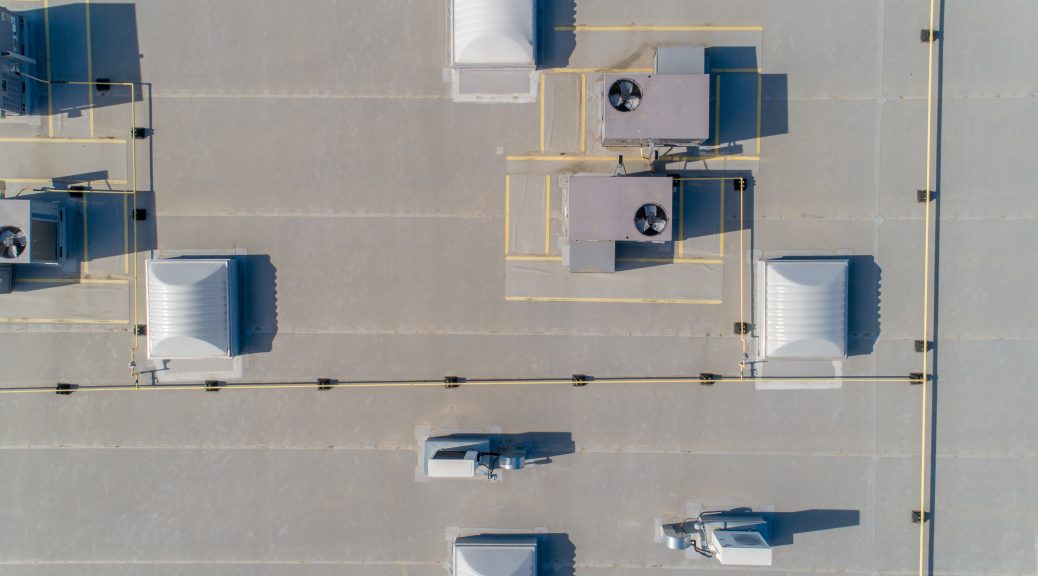With rough summer storms rolling through, you might worry about your roof more than usual. While you might be comforted by a quick look from the ground, you should know that some storm damage can be hidden below the surface.
While a professional roofer should be the one to do a closer inspection, you should take the time to learn about the potential damage your roof faces and what a roofer will look at after a big thunderstorm rolls through. If you think you might be facing hidden storm damage, call us at Heidler Roofing, and we’ll have a trained eye on your business ASAP.
Types of Hidden Roof Damage
When a storm blows through town, you might see wind gusts pulling up roofing, hail pummeling eaves, and rain slipping underneath your roof’s surface. These are the most common ways that storm damage is caused, though downed trees and flying debris are more obvious and eye-catching. Here are some of the ways that damage stays hidden from sight:
Roof surface Damage
Flat or low-angle roofing is most common on commercial buildings. These roof types are often more durable but can face just as much damage from harsh storms. Debris and hail might damage the flat surface, resulting in weakening or subtle tears in the material that can’t be easily seen. Depending on the material it is made of, a commercial building’s roof might also be more susceptible to hail and damage from fast temperature changes.
Flashing Damage
Flashing is the metal edge around your building’s chimney, walls, and other points where the roof meets a vertical surface. This material guides water away from sensitive areas and corners, where it can pool and cause corrosion. Flashing can face similar threats from wind damage that paneling can face, where it is pulled and pried away from the surface it is supposed to protect.
Roof paneling Damage
The bulk of a commercial roof is typically made up of TPO or EPDM, which is nailed into place or glued down and secured. This provides the waterproofing and sun protection that keeps you safe and cozy inside. The major form of wind damage is loosened or pulled away paneling that occurs during strong gusts of wind storms. This harm leads to stress where the paneling is weak or poorly installed, which causes a potential avenue for water penetration.
How Storms Damage Your Roof
Depending on your business’s recent challenges, you might expect to see different types and signs of storm damage. Wind storm damage and hail storm damage pose various threats to your business.
Wind Damage
Storm damage is most commonly caused by wind and gusts. Tornadoes and simple wind storms can cause many common roofing issues, such as:
- Flat roofing pulled away from the roof surface
- Roofing panels that are lifted, warped, or cracked
- Cracks or chips in siding, paint, or wood
- Dings and dents from debris striking roofing or siding
Early signs of wind damage include loose or shifted roofing panels and drafts or temperature differences in your business.
Water Damage
Wind can weaken your roof, making water damage more likely. When that firm contact between roofing panels and the roof plane is disrupted, it can lead to:
- Bacteria, mildew, and mold inside your business
- Soggy, swollen wood in your attic or roof
- Leaks in your ceiling and roof
Early signs of water damage include musty smells, dark or wet spots on your ceiling, or even sagging ceilings.
Hail Damage
Hail damage is usually apparent—dents, dings, chips, and other signs of roof damage can be clearly visible. But some issues might be less obvious:
- Hairline fractures to roofing panels, downspouts, and gutters.
- Cracks and damage to the roof plane underneath the roof plane
- Warped or bent roofing panels, flashing, or metal siding
Hail damage is the least common storm damage but can often be easier to assess.
What to Do After a Storm

Storm damage requires capable eyes to assess accurately. The first thing you should do is call a professional roofer who can adequately evaluate your commercial roof’s repair needs. In the meantime, there are some things that you can do after the weather clears to ensure your roof stays safe and sound.
- Prioritize Safety: Don’t go up on your roof alone! Walking around your roof’s surface is generally not advised, but if you’re committed to doing your check before calling a roofer, prioritize safety with the buddy system.
- Prevent Further Damage: If you can do this safely, you can try to prevent damage from worsening. For example, a tarp can cover loose or damaged roof panels to prevent water penetration. Permanent repairs may take some time.
- Document Damage: One thing that should definitely happen is documentation. For insurance, roofers, and anybody else who needs to know, taking photographs of damaged or missing roofing is good for you financially and your roofer professionally.
Once your roofer arrives, these steps that you take can help get them up to speed on your business’s well-being and get started on adequately addressing the storm damage that your business has experienced.
Expose and Resolve Hidden Storm Damage and Call Heidler Roofing Today!
Whether you’re facing subtle water penetration or apparent tree damage, Heidler Roofing can be on location in no time! Your business can face many concerning issues after simple rain or terrifying tornadoes. Don’t leave your business’s safety in the hands of just any company.
Heidler is a helpful and reputable roofing company that has dealt with damage of all kinds. We have helped fix roofs throughout the Mid-Atlantic area and are ready to help do the vital job of post-storm damage fixes.


